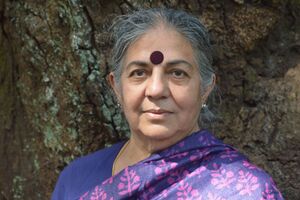Ecofeminism: Difference between revisions
Jump to navigation
Jump to search
No edit summary |
No edit summary |
||
| Line 1: | Line 1: | ||
<span class="mw-page-title-main"><span style="">Ecofeminism</span></span> | |||
<div id="bodyContent" class="vector-body"><div id="mw-content-text" class="mw-body-content mw-content-ltr" dir="ltr" lang="fr"><div class="mw-parser-output"><p><span style="font-size: 10pt;" >'''A branch of feminism that encompasses the concepts of ecology and feminism.'''</span></p><p><br></p><p><span style="font-size: 10pt;" >Although the term originated in the 1970s, many consider that ecofeminist practices have existed for much longer. Just as it is customary to speak of feminisms in the plural rather than feminism, ecofeminists will often use the term in the plural, that is to speak of ecofeminisms, in order to represent the diversity of experiences and points of view. M</span><span style="font-size: 10pt;" >ost agree that there is a connection (spiritual, material, or both) between the oppressions experienced by women and environmental destruction.</span><br></p></div></div></div> | <div id="bodyContent" class="vector-body"><div id="mw-content-text" class="mw-body-content mw-content-ltr" dir="ltr" lang="fr"><div class="mw-parser-output"><p><span style="font-size: 10pt;">'''A branch of feminism that encompasses the concepts of ecology and feminism.'''</span></p> | ||
<p><br></p> | |||
<p><span style="font-size: 10pt;">Although the term originated in the 1970s, many consider that ecofeminist practices have existed for much longer. Just as it is customary to speak of feminisms in the plural rather than feminism, ecofeminists will often use the term in the plural, that is to speak of ecofeminisms, in order to represent the diversity of experiences and points of view. M</span><span style="font-size: 10pt;">ost agree that there is a connection (spiritual, material, or both) between the oppressions experienced by women and environmental destruction.</span><br></p></div></div></div> | |||
{| class="wikitable" style="border-collapse: collapse; width: 100%; height: 16px;" | |||
{| class="wikitable" style="border-collapse: collapse; width: 100%; height: | |- style="height: 16px;" | ||
|- style="height: | | style="width: 100%; height: 16px;" | [[File:Wangari muta maathai first black woman to win nobel peace prize.jpeg|300x300px|left|middle|border]]<p><span style="">Wangar </span><span class="js-about-item-abstr"><span style="">ĩ</span></span><span style=""> Muta Maathai (Kenya) was awarded the Nobel Peace Prize in 1977 and founded the Green Belt Movement to fight against deforestation by enabling women to learn how to take care of the trees in their homes. community.</span><br></p> | ||
| style="width: 100%; height: | |- | ||
| style="width: 100%;" | <p>'''<span style=""></span>'''</p>[[File:Th-2106642000.jpeg|300x300px|left|middle|border]]'''Maude Prud'homme'''<span style=""> (Quebec) fight against the development of hydrocarbon projects and for the protection of ancient forests. She offers training on </span><span style="">ecofeminism.</span>[[File:Wangari muta maathai first black woman to win nobel peace prize.jpeg|300x300px|left|middle|border]] | |||
Wangar<span class="js-about-item-abstr">ĩ</span> Muta Maathai (Kenya) | |- | ||
| | | style="width: 100%;" | '''<span style="">[[image:800px-F_k93v5ur74-scaled-4120950346.jpeg|300x300px|left|middle|border]]Vandana Shiva</span>'''<span style=""> (India) is known for her fight against GMOs and for the preservation of traditional agricultural knowledge, she is considered an important ecofeminist figure of our time</span><p>'''<span style=""><br></span>'''</p> | ||
| style=" | |||
'''Maude Prud'homme''' ( | |||
|- | |||
| style="width: 100% | |||
|} | |} | ||
Revision as of 18:54, 22 August 2023
Ecofeminism
A branch of feminism that encompasses the concepts of ecology and feminism.
Although the term originated in the 1970s, many consider that ecofeminist practices have existed for much longer. Just as it is customary to speak of feminisms in the plural rather than feminism, ecofeminists will often use the term in the plural, that is to speak of ecofeminisms, in order to represent the diversity of experiences and points of view. Most agree that there is a connection (spiritual, material, or both) between the oppressions experienced by women and environmental destruction.


